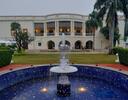Religious, Cultural & Spiritual Journey of India
We take immense pleasure presenting an itinerary that is essence of India, an itinerary that is going to be in demand for years to come, an itinerary that covers the religious, cultural & spiritual dynamism of India, an itinerary that covers past & present of India … An itinerary that will give you an insight into Incredible land of India !
Ayodhya – Ayodhya, located on the banks of river Sarayu is one of the seven sacred cities for Hindus. Ayodhya plays a critical role in the Hindu epic of Ramayana as it is the birthplace of Lord Rama. A grand Shri Ram Temple has been constructed & opened for worshipers & visitors in Jan. 2024.
Varanasi - Varanasi is the holiest city of the Hindu world, filled with temples and teeming with cultural life. In Varanasi, the Ganges river is considered a living goddess who is revered as Ganga Ma.
Come ... Let's embark on this Historical, Spiritual & Religious Journey of India !
Itinerary
- Day 1
Arrival Ayodhya / Visit Shri Ram Temple
Upon arrival at Ayodhya, Meet & greet by our rep., Transfer to hotel for check in
Ayodhya, located on the banks of river Sarayu in Uttar Pradesh, is one of the seven sacred cities for Hindus. Ayodhya plays a critical role in the Hindu epic of Ramayana as it is the birthplace of Lord Rama. This religious town is also the birthplace of four of Jainism's 24 Tirthankaras (religious teachers), beckoning tourists with its serene ghats.
With monkeys galore, the buzz of the visiting tourists, and a general spiritual aura, Ayodhya has been surrounded by controversy since about a decade now. It is the site of the 1992 Indian riots related to the Babri Masjid fiasco. The mosque, which was allegedly built on Ram Janmabhoomi Temple, became the bone of contention between Hindus and Muslims. In 2005, Ayodhya witnessed a terrorist attack at the site of Ramlalla Temple.
Despite the controversy, Ayodhya has so much colour and spirituality to see for its tourists and has emerged as a significant spiritual centre. The land of multi-faith temples, the traffic-free streets of Ayodhya are intriguing enough in itself to warrant a visit.
Later visit Shri Ram Temple
Ramjanma Bhoomi, Ayodhya
Translating to Ram's Birthplace, the Ram Janmabhoomi is believed to have been the birthplace of the Hindu deity, Lord Ram. According to the Indian epic Ramayan, Ram, Lord Vishnu's seventh manifestation, is said to have grown up along Ayodhya's river Sarayu. The Ram Janmabhoomi is a highly revered site for Hindu devotees.
After being a conflicted site for decades, the Ram Janmabhoomi land was handed over to a trust by the Supreme Court of India to build the Ram Temple. The groundbreaking ceremony for laying of the foundation stone for the Ram Temple of Ayodhya was performed on 5 August 2020 by Prime Minister Narendra Modi. The proposed design of the temple is grand and magnificent.
Overnight at Ayodhya - Day 2
Ayodhya - Prayagraj [Allahabad] - Varanasi
After breakfast, depart for Varanasi
Enroute visit Prayagraj [Allahabad] ... 170 kms., 4 hrs. drive
Prayagraj & Triveni Sangam
Brahma, the Hindu god of creation, is believed to have landed on earth in Prayagraj (or Allahabad as it was known until recently), and to have named it the king of all pilgrimage centres. Indeed, Sangam, a river confluence on the outskirts of the city, is the most celebrated of India’s four Kumbh Mela locations. The point of confluence is a sacred place for the Hindus, as it is of high religious importance to the Hindus. A bath here is said to wash all the sins and free human from the cycle of birth. The site of Sangam is a treat to the eyes. One can see the muddy and pale yellow water of Ganges merging with green water of Yamuna. The Ganges is only 4 ft deep, while Yamuna is 40 ft deep near the point of nexus. The river Yamuna ends at this point and Ganges continues after this till it meets sea at Bay of Bengal.
Continue drive to Varanasi ... 120 kms., 2 to 3 hrs. drive
Varanasi
Varanasi is the holiest city of the Hindu world, filled with temples and teeming with cultural life. In Varanasi, the Ganges river is considered a living goddess who is revered as Ganga Ma.
Without the river Varanasi would not exist as we know it. Considered as the abode of Lord Shiva, River Ganges is believed to have the power of washing away all of one's sins. As pundits here will tell you, whatever is sacrificed and chanted here or given in charity reaps its fruits thousand times more than those good deeds performed at other places because of the power of that place. It is believed that three nights of fasting in Varanasi city can reap you rewards of many thousands of lifetimes of asceticism!
Most visitors agree Varanasi is magical – but not for the faint-hearted. Intimate rituals of life and death take place in public, and the sights, sounds and smells on the ghats – not to mention almost constant attention from touts – can be intense. Still, the so-called City of Lights may turn out to be your favourite stop of all.
Check in at hotel
Overnight at Varanasi - Day 3
Varanasi sightseeing
Early morning Boat Ride on the Ganges
We rise before dawn and step gingerly in the boat as the boatman starts rowing the boat. We wait for the daily miracle to unfold, as the Sun appears triumphantly over the horizon. The sound of conches and temple bells add to the delicate pink fabric of dawn. The formerly hushed murmuring of ancient Sanskrit ‘Shlokas’ now rises, in one voice, to a crescendo of unparalleled piety and joy.
Back to hotel in time for breakfast
Later visit Kashi Vishwanath Temple
There are temples at almost every turn in Varanasi, but this is the most famous of the lot. It is dedicated to Vishveswara – Shiva as lord of the universe. The current temple was built in 1776 by Ahalya Bai of Indore; the 800kg of gold plating on the tower and dome was supplied by Maharaja Ranjit Singh of Lahore 50 years later.
Kashi Vishwanath Temple, is one of the 12 Jyotirlinga temples where Shiva is believed to have appeared as a column of light.
There were several earlier versions of the temple, possibly dating back more than a thousand years. The first recorded large-scale reconstruction was sanctioned by the Mughal emperor Akbar in 1585, but his great grandson Aurangzeb ordered its demolition in 1699 and used its debris for a new mosque near the site. The present structure, which is popularly known as the Golden Temple because of the gold used in the later plating of its spires and domes, is believed to have been built during the 18th century by Ahalya Bai of the Holkar dynasty.
According to Hinduism, visiting the Kashi Vishwanath Temple and bathing in the Ganges are important stages on the path to liberation, or moksha. Tens of thousands of pilgrims visit the temple daily. Every year during Mahashivaratri, a great procession takes place from the Mahamrityunjaya Temple to the Kashi Vishwanath Temple.
Evening Aarti
Ganga Aarti at Dasaswamedh ghat, close to Kashi Vishwanath Temple, is one of the prime attractions of Varanasi. It starts just after sunset, with a bunch of young men choreographing to the chantings, holding the lamps. People start arriving at the ghats as early as 5pm. Dasaswamedh ghat becomes a hub of activity, with people sitting and waiting for the aarti, buying flowers and other things from nearby shops or performing Pooja. It is conducted every sunset by five white-robed priests - These five young men sway in seemingly choreographed movements, worshiping the river goddess with incense, camphor, flowers and earthen lamps. Thousands of illuminated lamps are immersed in the waters of the holy Ganges and the floating lamps add a divine look to the river at dusk. Sit with some ‘sadhu’ and enjoy knowing their lifestyle from close proximity. You might even run into someone who is more than 100 years old! The Ghats also provide a good option for photography with serene temples and their bustling courtyards creating a perfect backdrop.
Overnight at Varanasi - Day 4
Varanasi sightseeing
After breakfast, explore the city of Varanasi offering many places of sightseeing ...
Banaras University, Kal Bhairav temple, Annapurna devi temple, Vishalakhi temple, Durga Temple, Sankat Mochan Temple, Manas Mandir, Mother India Temple, Sarnath, etc.
Darshan & City Tour of Varanasi
Varanasi being a centre for Hindu customs, temples form the main attraction. The Ganga Ghats (river fronts) are the main center of religious activities and rituals and also form one of the main attractions of Varanasi. Some of the most important temples of Varanasi are Durga temple, Vishwanath temple, Sankat Mochan temple, Tulsi Manas temple and the Bharat Mata temple.
The Alamgir Mosque, blend of the Hindu and Mughal styles of the architecture, is another important attraction of Varanasi.
Shopping at Varanasi
Varanasi is also visited for the wonderful shopping options that are offered ... holy water of Ganga or Ganga Jal, Banarasi silk sari, crystal & stone Shivlinga, glass beads, Rudraksha mala, Flutes, Sweets, Ramnami cloths to name a few
Sarnath - 10 kms. from city
Sarnath, about 10 km from the holy city of Varanasi, is the place where Buddha chose to deliver his first sermon. The celebrated Mantra, 'Buddham Sharanam Gachhami', owes its origin to Sarnath. On the day before his death Buddha included Sarnath along with Lumbini, Bodh Gaya and Kushinagar as the four places he thought to be sacred to his followers. It makes Sarnath one of the most venerated Buddhist places. Besides Buddhism, Sarnath is also connected with Jainism. There are many Buddhist monuments and edifices in Sarnath.
Some of the important Buddhist monuments at Sarnath are the Dhamekha stupa, the
Chaukhandi stupa and monasteries and temples of different schools of Buddhism from Japan, China, Thailand, Burma and others. The Indian Buddhist society called Mahabodhi Society maintains a park around the Buddha temple. The Mahabodhi Temple within the park has a tooth relic of the Buddha.
Places of Sightseeing at Sarnath
Chaukhandi Stupa - It is situated 13 kilometers away from Varanasi, is said to be built originally as a terraced temple in 4th to 6th century during the Gupta period. The Chaukhandi Stupa is a brick structure crowned with an octagonal tower. According to the famous Chinese traveller Hiuen-Tsang, this was the tallest stupa at that time in the region. The octagonal tower was added to the structure during the reign of the Mughal Emperor Akbar in 1588, to commemorate the refuge given to Humayun in Sarnath.
Ashoka Pillar - The Ashoka pillar of Sarnath is the National emblem of India.The great Mauryan emperor Ashoka built a series of pillars throughout India and some parts of modern Pakistan and Afganistan and the Sarnath Pillar is probably the grandest of all. In its original form the Sarnath pillar stood at 12.25 m, having a diameter of 0.71 m at the base and 0.56 at the top and a Lion Capital was placed at the top with four back to back lions. The famous Ashoka Chakra topped this structure. The Ashoka pillar was broken during Turk invasions. The Ashoka Pillar and the Lion Capital were discovered during excavations in 1904 at Sarnath. The excavators also found fragments of the Dharmachakra /Ashoka Chakra around the Ashoka pillar. The Ashoka Lion Capital is exhibited at the Sarnath Archaeological Museum. The wheel fragments have been mounted on the walls of the museum.
Sarnath Archaeological Museum - It just across the road near to Ashoka Pillar. The ASI museum at Sarnath is an on site museum and houses a number of artifacts related to Buddhist art as well as many images and sculptures of Hindu Gods recovered during excavations in the region. The museum comprises of five galleries with two verandahs. Some of the prominent artifacts at the musem include a life-sized image of a standing Bodhisattva, a panel depicting Shiva slaying Andhakasura, and the most important being the Lion Capital. Photography is not permitted inside the Sarnath museum, which may come as disappointment to many visitors.
Standing Buddha statue - The latest addition to many tourist attractions at Sarnath is the standing Buddha statue at the Thai Buddha vihar. With a height o 80 ft, it is the tallest standing Buddha statue. This magnificent statue of Buddha was built over 14 years as a result of Indo-Thai joint effort.
Overnight at Varanasi - Day 5
Departure from Varanasi
Morning at leisure
Later transfer to airport as per flight schedule
Notes
Round the Year Destination ... Extension recommended to Lucknow & Gaya
Notes on itinerary
All our itineraries are "Just for Ideas" ... We will get to know you and customise an itinerary just for you that matches your requirements ... dates of travel, category of hotels, preferred airline, flexibility in choosing sightseeing, mode of travel between cities, etc.
Many of our clients have us design more relaxing, slower paced holidays with more in-depth experiences whereas some simply want to visit various destinations and cover only the highlights.
Together, we will determine the ideal route, pace of travel, accommodations, levels of pampering, style of touring, sightseeing to be included, dining preferences, adventure levels, options to meet locals, dates of travel & much more ! and based on this arrive at a price.
Do feel free to get in touch with us by a quick call on +91 79 29602961 or a short mail on mail@destinations4india.com ... Looking forward
















